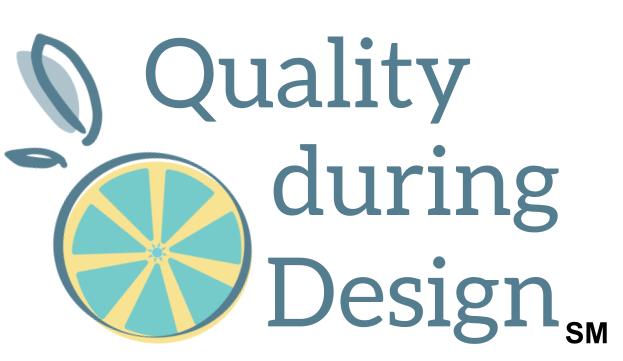If you're tuning in, you're probably a go getter, roll up the sleeves, get ‘r done type of person. And I'm guessing that you see some things that you think you could improve. Quality folks use and promote some standard problem solving and continuous improvement methods and you want to reference the right acronym to get buy-in for your improvement project. You may have heard of PDCA, PDSA, and DMAIC. You vaguely know there about improvement but don't really know what their differences are. When should you use which one and for what? This installment demystifies the titles and explores the history of each so you can talk about the right tool for your project. Listen in after this brief introduction.
Hello, and welcome to Quality During Design: the place to use quality thinking to create products others love for less! My name is Dianna. I'm a senior level quality professional an engineer with over 20 years of experience in manufacturing, design, and quality. Listen in and then join the conversation at qualityduringdesign.com.
So, there seems to be a lot of continuous improvement problem solving methods in the world of quality and it has developed over the last 100 years (so I had to look up a lot of history to be able to talk to you today about this). But it really gave perspective on why there are so many tools, how they developed, and why they were developed differently. I think it will give you a leg-up when you talk to the next quality practitioner about your improvement project.
There are really three major ones that we're going to talk about today. One of them is PDCA (plan do check act), the other is PDSA (S is for study), and DMAIC (define measure analyze improve and control). I'm even going to throw in there a couple that maybe you haven't heard of before: the Shewhart cycle and the Deming cycle. These are all problem-solving methods and frameworks for improvement; just methodical ways to go through an improvement project to make sure that you don't miss anything in your development. All of these tools are based on the scientific method, so before we dig deep into the origins of these tools, let's make sure we have some common ground about the scientific method. Because, when I was in school, I learned there is a three-step method. Now, my kids in school are learning about a six-step method, and I think I saw, like, a five or seven-step method on the Internet somewhere. The baseline iterative that we're going to talk about today is a three-step: 1) make a hypothesis, 2) test your hypothesis by carrying out an experiment, and 3) analyze and interpret your data against the hypothesis and make a conclusion. This is important for us to talk about because in 1939 Walter Shewhart introduced the Shewhart cycle.
Walter Shewhart is considered the father of statistical quality control. He was very much involved in developing quality methods and statistical methods application to mass production in the 1930s and 40s. He presented an idea to the US Department of Agriculture and later published in a book. His proposal was that we could apply the scientific method to mass production process steps. This is the key to all the other process improvement methods. The specification of our product from mass production could be considered the hypothesis of the scientific method, production was actually carrying out an experiment, and the inspection of parts afterwards is interpreting the data against the hypothesis. And then he made it a cycle so that the information from inspection feeds back into the specification or the hypothesis just like we would do with the scientific method. That was the Shewhart cycle.
Doctor W Edwards Deming was front row (so to speak) to Mr. Shewhart’s presentations. Whereas Shewhart proposed aligning the scientific method to mass production, Deming saw an opportunity to not just stop at the production phase, but to include how the products are being used in the market. He proposed a Deming wheel which was design-production-sales-research, and he thought it was important to have constant interaction between those four steps of design. He shifted the QA inspection part into production as part of production and added sell the product and test the product in service and through the market. It was still a cycle: service and market data fed back into the design.
Now in our timeline we're in the 1950s where there's a divergence of ideas. Deming presented the Deming wheel idea in 1950 during a seminar in Japan. It was an 8-day seminar, a pretty big deal, sponsored by the Japanese Union of Scientists and Engineers. In 1951, Japanese executives recast the Deming wheel cycles into PDCA: plan-do-check-act. Their emphasis was on prevention methods where “act” added establishing standards and ongoing modifications to those standards. The PDCA remained largely unchanged until the 1980s. In 1985, Karo Ishikawa updated the PDCA to align with Total Quality Control, or management initiatives, or kanri. He added more expectations to the planning phase: instead of just planning, plan for goals and targets, and plan for the methods that you're going to use to reach those goals. There was also in addition to the “do” part, where training an education was added as part of the cycle. PDCA became known as the QC-circle (or the quality control circle). The PDCA cycle, the seven basic tools, and the quality control initiative together form the foundation of Kaizen (or improvement) that still used in Japan today.
In the 1980s, one year after Ishikawa updated the PDCA, Dr. Deming republished the Shewhart cycle. He continued to develop and promote that cycle, and in 1993 he published the PDSA: plan-do-study-act, or the “Shewhart Cycle for Learning and Improvement”. Dr. Deming strongly distinguished PDSA from PDCA, maintaining that they were not the same. There was a highlighted difference between the S and the C in these two process flows, where check is associated with faults encountered at the local level and study was part of a flow diagram for learning and improvement of a product or process. Dr. Deming tried to continue to develop it, and other people continue to build upon PDSA through at least the 1990s. Another version of it, the SDSA, has been generated, which is standardize-do-study-adjust, a cycle used to standardize improvements.
PDSA is sometimes compared with DMAIC as problem solving methods go. Their goals are the same: to provide a structure to the improvement efforts, to help people avoid changes without a thorough understanding of root causes or issues, and to make the improvements stick. However, there are differences, and these two methods are not interchangeable. PDSA is associated with small to medium-sized problems: quick winds that add up. DMAIC are for projects with big risk or they’re expensive to implement. They’re large, complex problems that need cross functional collaboration. DMAIC is a linear process with a distinct beginning and end, compared to PDSA which is a cycle of continuous improvement.
DMAIC (define-measure-analyze-improve-control) is an improvement process prescribed by Six Sigma, and Six Sigma is an approach that is focused on quality, eliminating defects through reduced variation. It was developed in the 1980s and 1990s. There is a heavy emphasis on data; there is usually a lot of data used to drive decisions. There's also a heavy emphasis on planning: the D, the M, and the A sections of the DMAIC method can be lined up with just the P section of the plan-do-study-act method. There has also been some variations developed from this method, too: there's a DMADV (define-measure-analyze-design-verify) and this is really for the development of new products or services. DMAIC projects are usually run by someone trained as a Six Sigma belt.
Hey, we did it! We reviewed almost 100 years of development of quality improvement models!
There are two main takeaways that I have. For one, all of these models are rooted in the scientific method. If you're involved in an improvement team and you're using one of these models and you get in the weeds and kind of lost (not quite sure what it is you're trying to accomplish with a particular step or process), maybe step back and just realize that this is a scientific method in action. Maybe that'll help orient you on the path to success! The other main takeaway that I have is that these improvement models are themselves being continuously improved! And why not? I think it's wonderful that people are using the models, seeing what works, and then communicating it to the rest of us their lessons learned so that we can continue to improve upon what we do. One of my favorite quotes is by Sir Isaac Newton who said, “If I have seen further than others it is by standing up on the shoulders of giants,” and I think that applies to this, too.
Our ultimate question, then, is when do you use which tool? It depends on the change that you're making, its scope, and how your organization is structured.
I would recommend starting with PDCA if it meets these requirements: if your organization emphasizes the seven quality tools and quality control, and if your improvement project is associated with production of products then I would use the PDCA. The best place to probably get started is to talk to the facility quality engineer.
PDCA is sometimes referred to interchangeably with PDSA but realize that not everyone agrees that they are the same. I would start with PDSA if your improvement project meets these requirements: if it's related to management controls (or things outside of production), and your problem is small to medium sized, and it's an improvement that can be continuously improved so that you get those quick wins that add up over the long term, then your project best fits the PDSA model. To get started I would recommend talking to a quality manager that's involved with the company's quality management system. If you need cross functional resolution where representatives from multiple departments need to be involved, maybe tie it in with a Tiger Team approach.
Lastly, I would start with DMAIC if your organization follows Six Sigma or Lean Six Sigma methodologies, if you've got a really big project with lots of data, and cross functional needs, DMAIC is probably the best fit. The best way to start with that is to approach a belt to get started. This is a person within your organization that is a Six Sigma green belt, yellow belt, or black belt. Your project will likely get added to a roster of improvement projects where it will be prioritized with the other projects.
If you don't have an improvement project you're working on right now, find out which ones are happening today in your organization. See if you can find out or figure out what method they're using now.
I want to hear from you. Let me know: what are times you followed through or have been a part of PDCA, PDSA, or DMAIC? What was the purpose of the project, and did the process help your team? Head over to qualityduringdesign.com to this podcast blog and share your story in the comments section. The blog will also contain a list of citations for the materials I used to create this podcast. You can visit our full catalog anytime at qualityduringdesign.com.
This has been a production of Deeney Enterprises. Thanks for listening!

